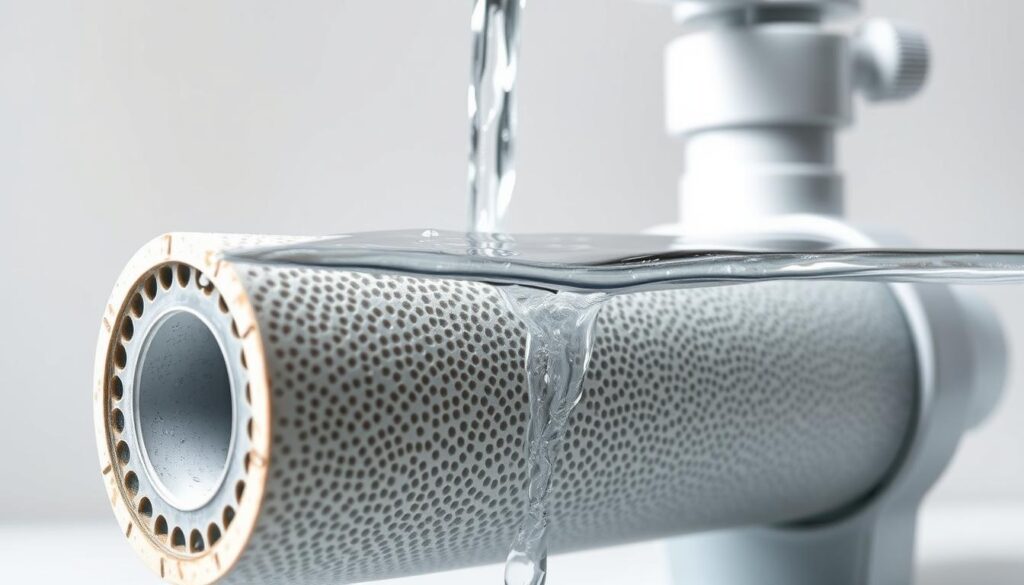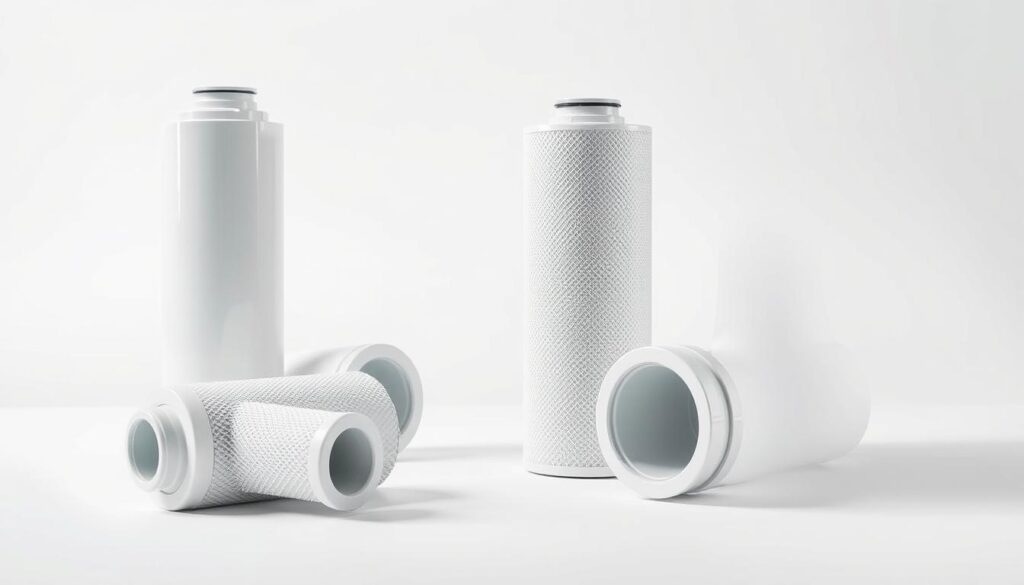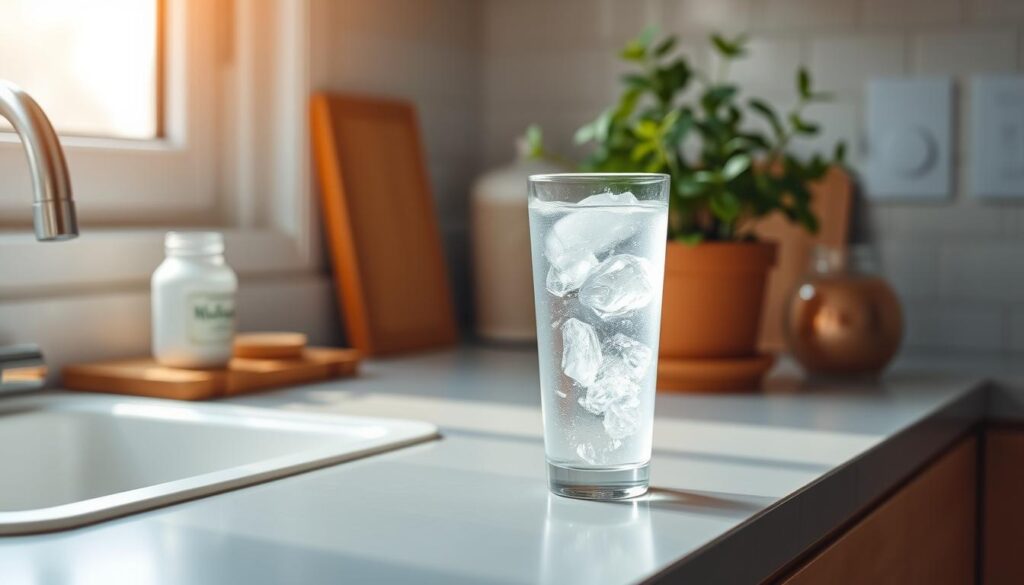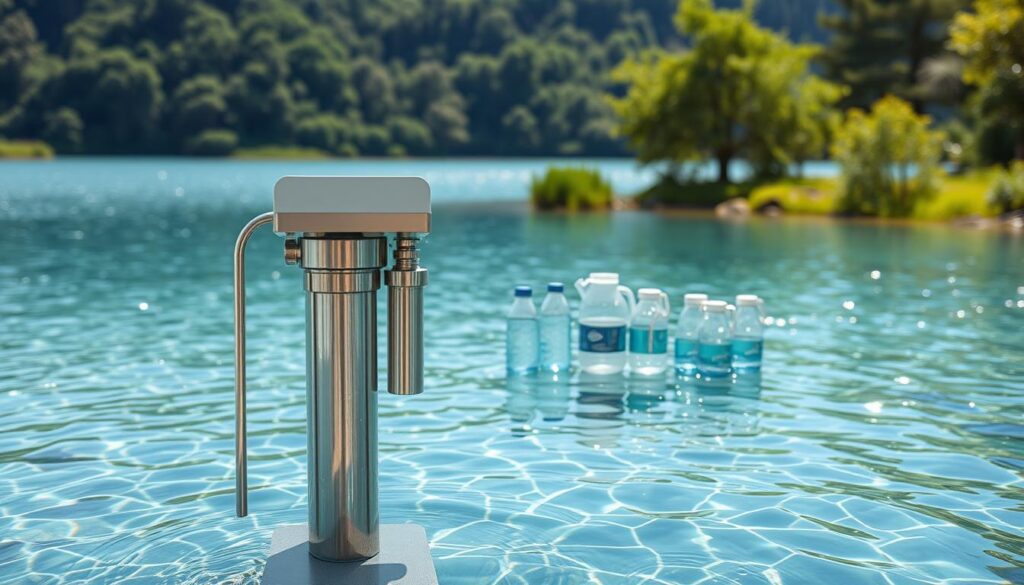Having clean drinking water is key for our health. But pollution and contamination make it hard to keep water pure. That’s why effective water purification systems are important.
Ceramic water filters are a top choice for cleaning water. The OA Guide to Water Purification shows they trap particles well. They work against protozoa, bacteria, and some viruses.
Using water purification systems is very important. This is true, even more so in places where clean water is hard to find. Knowing how to use and care for ceramic water filters helps get safe drinking water.
Key Takeaways
- Clean drinking water is vital for our health.
- Ceramic water filters are a great way to purify water.
- They can remove many contaminants, like protozoa and bacteria.
- It’s important to know how to use and maintain ceramic filters.
- Good water purification systems are essential in areas with little clean water.
What Are Ceramic Water Filters?
It’s important to know about ceramic water filters to make smart choices for clean water at home. These filters use a special ceramic material to clean water. They are a good choice for anyone wanting safe drinking water.
Definition and Composition
Ceramic water filters are made from ceramic elements, often a mix of clay and other materials. They are fired at high temperatures to become porous. This lets water through but keeps contaminants out. Some filters also use activated carbon for better cleaning.
The ceramic filter cartridge is key for filtering water. The OA Guide to Water Purification says ceramic filters are vital for cleaning water. They remove contaminants effectively.
Types of Ceramic Filters
There are many types of ceramic filters, each meeting different needs. Here are a few:
- Filters with different pore sizes for varying levels of filtration and contaminant removal.
- Filters with extra purification steps, like activated carbon, for better taste and chemical removal.
- Gravity-fed filters, perfect for homes, as they use gravity to filter water.
Water purification guides point out that ceramic filters come in many varieties. This lets users pick the best one for their needs, whether it’s for a small home or a big community.
How Do Ceramic Water Filters Work?
It’s important to know how ceramic water filters work to understand their role in cleaning water. These filters are popular because they are effective at filtering water.
Ceramic water filters use a porous ceramic element. This element traps contaminants, letting clean water pass through. This is the core of their design and how they work.
The Filtration Process
The process of filtering water in ceramic filters involves a ceramic element with tiny pores. These pores are so small they block bacteria, viruses, and other contaminants. This ensures the water is clean.
- The ceramic element is made from a mix of ceramic materials and other substances to improve its filtering.
- As water flows through the filter, contaminants get trapped, and clean water comes out.
- This method is not only effective but also eco-friendly. It doesn’t need chemicals or electricity.

Key Advantages of Using Ceramic Filters
Ceramic water filters have several key benefits that make them a good choice for cleaning water. Some of these benefits include:
- Eco-friendliness: Ceramic filters are made from natural materials and don’t contain chemicals. They are good for the environment.
- Cost-effectiveness: Even though they might cost more at first, ceramic filters last a long time. They can be a cost-effective choice in the long run.
- Effectiveness against pathogens: Ceramic filters are very good at removing a wide range of pathogens, including bacteria and viruses.
In summary, ceramic water filters are a reliable and effective water filtration solution. They can be used in many places, from homes to community water systems.
Benefits of Using Ceramic Water Filters
Ceramic water filters offer many benefits, like healthier drinking water and less harm to the environment. They are becoming more popular because they work well and are good for the planet.
Health Benefits
Ceramic water filters are great at removing harmful germs from water. This makes the water safe to drink, which is key for staying healthy. The filters use a ceramic element to catch and remove contaminants.
Using these filters can help prevent waterborne diseases. The World Health Organization says they can cut down on diseases like diarrhea. These diseases often come from drinking contaminated water.
Environmental Impact
Ceramic water filters also help the environment. They let people stop using so much bottled water, which cuts down on plastic waste. It’s known that millions of tons of plastic waste come from bottled water each year.
Also, ceramic filters are a green choice for water treatment. They can last for years with the right care. This makes them better for the planet than other methods that need to be replaced often.
Cost Effectiveness
Ceramic water filters are also a smart choice for your wallet. Even though they cost a bit upfront, they save money in the long run. They are cheaper than buying bottled water all the time.
| Filter Type | Initial Cost | Maintenance Cost | Cost per Liter |
|---|---|---|---|
| Ceramic Water Filter | $20-$100 | $5-$10 (replacement elements) | $0.02-$0.05 |
| Bottled Water | $0 | $1-$3 per liter | $1-$3 |
The table shows how ceramic water filters save money over time. They are a smart choice for many families because they are affordable.
Choosing the Right Ceramic Water Filter
To ensure effective water filtration, picking the right ceramic water filter is key. Look for a filter that fits your household’s needs. Several factors are important to consider for the best choice.
Factors to Consider
When picking a ceramic water filter, think about filter lifespan, flow rate, and maintenance requirements. A longer filter life means less often you need to replace it. A good flow rate ensures you always have clean water. How easy it is to maintain the filter also matters.
It’s also important to know what contaminants you want to remove. Some filters target bacteria, viruses, and parasites. Others can remove heavy metals or chemicals. Knowing your needs helps you pick the right filter.
Popular Brands and Models
Many trusted brands offer top-notch ceramic water filters. Look into brands that focus on household water filters and ceramic cartridges. These brands have various models with different features, like flow rates and lifespans.
When comparing models, consider the total cost. This includes the price of replacement filters and the manufacturer’s customer support. This helps you make a well-informed decision.

Maintenance and Care for Ceramic Water Filters
Keeping ceramic water filters in good shape is key to their success. They need regular care to keep your water clean and safe. Knowing how to maintain them is essential.
Cleaning Techniques
Cleaning the filter regularly is a must. Gently scrub the ceramic element with a soft brush under running water. This helps remove any debris or contaminants.
For tougher cleaning, try soaking the filter in a mix of water and vinegar. This can help get rid of stubborn dirt.
How often you need to clean the filter depends on how much you use it and the water quality. Regular inspection will tell you when it’s time for a clean.
Replacement Timelines
Knowing when to replace the filter is important. The lifespan of a ceramic filter varies. It depends on usage, water quality, and filter design. Usually, you’ll need to replace it every few months or as the manufacturer suggests.
To get the most out of your eco-friendly water filter, follow the manufacturer’s replacement advice. Sustainable water treatment practices, like proper disposal and replacement, are key to the filter’s success.
- Monitor the filter’s performance and appearance.
- Replace the filter as recommended by the manufacturer.
- Consider the water quality and usage patterns when determining replacement frequency.
Troubleshooting Common Issues
It’s important to fix common problems with ceramic water filters quickly. Issues like clogging and damage can lower the filter’s water purification power.
Identifying Clogs
A clogged ceramic water filter can slow down water flow and lower filtration efficiency. Look for signs like slow water flow or increased pressure on the filter. Cleaning the filter regularly can help avoid clogs.
Here’s a simple way to check for clogs:
- Remove the filter from the filtration system.
- Inspect the filter for visible debris or sediment buildup.
- Clean the filter according to the manufacturer’s instructions.
Signs of Damage
Damage to ceramic water filters can make them less effective at removing contaminants. Look for cracks, chips, or visible wear on the filter. Regular checks can spot damage early, so you can replace it on time.
To better understand damage signs and how to spot them, see the table below:
| Type of Damage | Signs to Look For | Recommended Action |
|---|---|---|
| Cracks | Visible cracks on the filter surface | Replace the filter immediately |
| Chips | Chipped edges or surfaces | Inspect further for other damage; consider replacement |
| Wear | Visible wear or erosion of the filter material | Replace the filter as needed |
Knowing about these common issues and how to spot them helps keep ceramic water filters working well. Regular maintenance and checks are essential for water purification systems with ceramic filters.

DIY Installation of Ceramic Water Filters
Installing a ceramic water filter yourself can be easy with the right tools and materials. Just follow the manufacturer’s instructions and take the right precautions. This will help you do a successful installation.
Required Tools and Materials
Before you start, make sure you have everything you need. You’ll need:
- The ceramic water filter unit
- A filter wrench or replacement parts as specified by the manufacturer
- Tubing or pipes for connecting the filter to your household water supply
- Teflon tape or pipe dope for creating a watertight seal
It’s also smart to have a bucket or container ready. This is for catching any water that might spill during the installation.
Step-by-Step Installation Guide
With all your tools and materials ready, you can start the installation. Here’s how to do it:
- Turn off the main water supply to your household.
- Find the spot where you want to put the ceramic water filter. It’s usually under the sink or near the main water supply line.
- Use the filter wrench to take out any old filter or fittings from the chosen spot.
- Put Teflon tape or pipe dope on the threads of the new filter. Then attach it to the spot you picked.
- Connect the tubing or pipes to the filter. Use the provided fittings to secure them.
- Turn on the main water supply and check for leaks.
By following these steps and using the right tools and materials, you can have clean drinking water with your new ceramic filtration system. Remember to do regular maintenance and replace the filter elements. This will keep your household water filters working well.
Comparing Ceramic Filters with Other Filtration Methods
There are many water filtration options out there. It’s important to compare them to make the right choice. Ceramic water filters are one option, and knowing how they compare to others can help you pick the best one.
Activated Carbon Filters
Activated carbon filters are known for removing chlorine, taste, and odor from water. But they might not catch all bacteria, viruses, or heavy metals like ceramic filters do. Ceramic filters can remove particles and microorganisms, making them a better choice for purifying water.
Reverse Osmosis Systems
Reverse osmosis (RO) systems can remove many contaminants, including dissolved solids and viruses. Yet, they can waste a lot of water during the process. Ceramic filters, on the other hand, are more water-friendly and often use less energy.
UV Filters
UV filters kill bacteria and viruses with ultraviolet light. But they don’t remove particles or chemicals. Ceramic filters can handle a wider range of contaminants, including sediments and heavy metals, without extra steps.
In summary, each filtration method has its own advantages and disadvantages. By understanding your water needs and the features of different systems, you can pick the most effective and eco-friendly filter for you.
Where to Buy Ceramic Water Filters
Buying a ceramic water filter is now easier than ever. You can find them online or in stores. Whether you want a specific brand or just want to see what’s out there, there are many places to look.
Online Retailers
Online stores make it easy to buy ceramic water filters from home. Some top sites include:
- Amazon
- REI
- Specialty health and wellness stores
These websites have reviews, comparisons, and detailed info. This helps you choose wisely. Always check the seller’s ratings and reviews to buy from a trusted source.
Local Stores
If you like to shop in person or need a filter fast, local stores are a good choice. You can find ceramic water filters at:
- Outdoor and camping stores
- Health food stores
- Specialty kitchen and home goods stores
Shopping in stores lets you see the product and ask questions. This can help you make a better choice.
Tips for Buying: Whether online or in-store, remember a few things. Make sure the product is certified by a trusted group, like NSF International. Also, think about how long the filter lasts, how much it costs to replace, and the manufacturer’s customer support.
By thinking about these points and looking at both online and local stores, you can find the best ceramic water filter for you. This helps make your water treatment more sustainable at home.
My Personal Experience with Ceramic Water Filters
I started using a ceramic water filter because it’s good for the planet. It cuts down on plastic bottle waste. I was amazed at how well it keeps my water clean.
Effectiveness and Ease of Use
The ceramic filter is a trusted way to get clean water. It works without needing electricity or a hard setup. This makes it a top choice for those who care about the environment.
Long-Term Satisfaction
The filter keeps on delivering clean water over time. It doesn’t slow down much, which makes me happy I chose it. It’s a smart move towards a cleaner, greener way of getting water.
My time with ceramic water filters has shown me their value. I think they’re a great option for anyone looking for a green and reliable way to get clean drinking water.
FAQ
What is the effectiveness of ceramic water filters in removing contaminants from drinking water?
Ceramic water filters are very good at removing harmful stuff from water. They can get rid of bacteria, viruses, and parasites. This makes the water safe to drink. They can remove up to 99.99% of contaminants, depending on the filter’s quality.
How often should I replace my ceramic water filter cartridge?
How often to replace your filter cartridge depends on the maker’s advice and how much you use it. Usually, you should replace it every 1-3 years or after filtering a certain amount of water.
Can ceramic water filters be used with well water or only with municipal water?
Ceramic water filters work with both well water and city water. But, if you have well water, you should test it often. This makes sure the filter works against the specific bad stuff in your water.
Are ceramic water filters eco-friendly?
Yes, ceramic water filters are good for the planet. They help cut down on bottled water use, reduce waste, and are often made from natural materials.
How do I clean and maintain my ceramic water filter?
To keep your filter clean, gently scrub it with a soft brush and rinse it with clean water. Regular cleaning and proper storage can make the filter last longer.
Can I use a ceramic water filter with cold or hot water?
Most ceramic water filters are for cold water only. Hot water can harm the filter or make it less effective. Always check the maker’s advice before using it with hot water.
What are the benefits of using a ceramic water filter compared to other filtration methods?
Ceramic water filters have many advantages. They remove contaminants well, are good for the environment, and are cost-effective. They also don’t take out good minerals from the water, unlike some other methods.
Are ceramic water filters certified by any reputable organizations?
Yes, many ceramic water filters have certifications from trusted groups like NSF International or the Water Quality Association. These groups test and confirm the filter’s effectiveness against certain contaminants.
Can I install a ceramic water filter myself, or do I need a professional?
Many ceramic water filters are easy to install yourself. The makers usually provide clear instructions. But, if you’re not sure or don’t feel comfortable with the installation, it’s best to get help from a professional.



